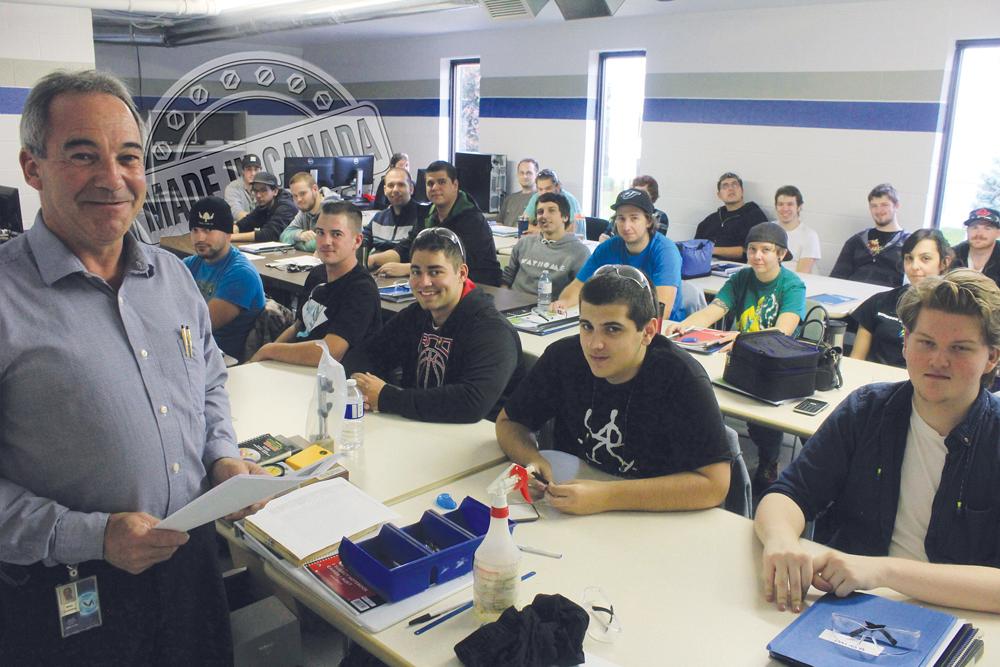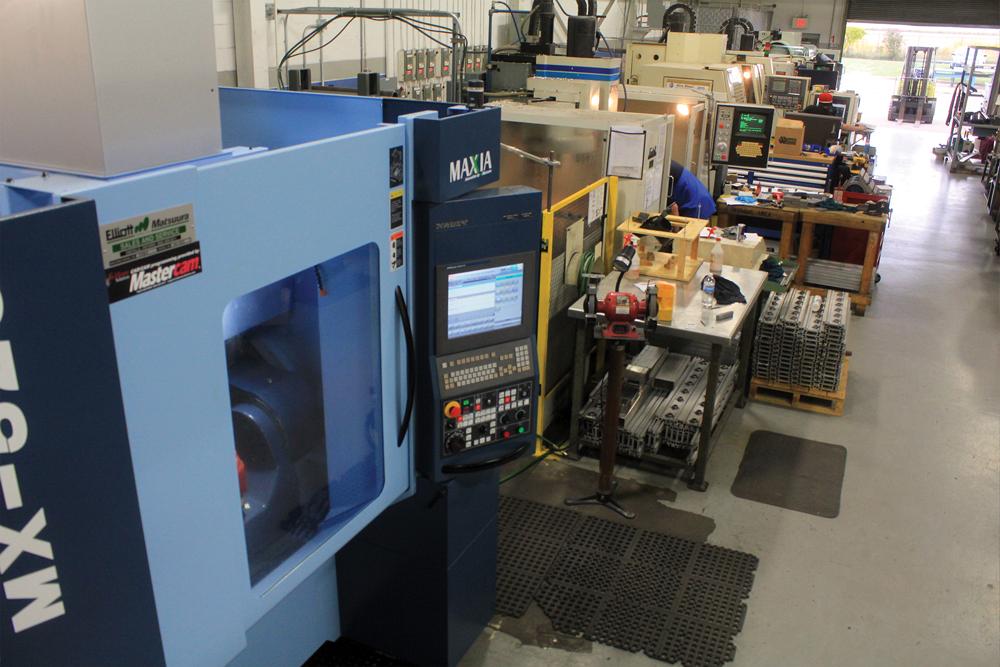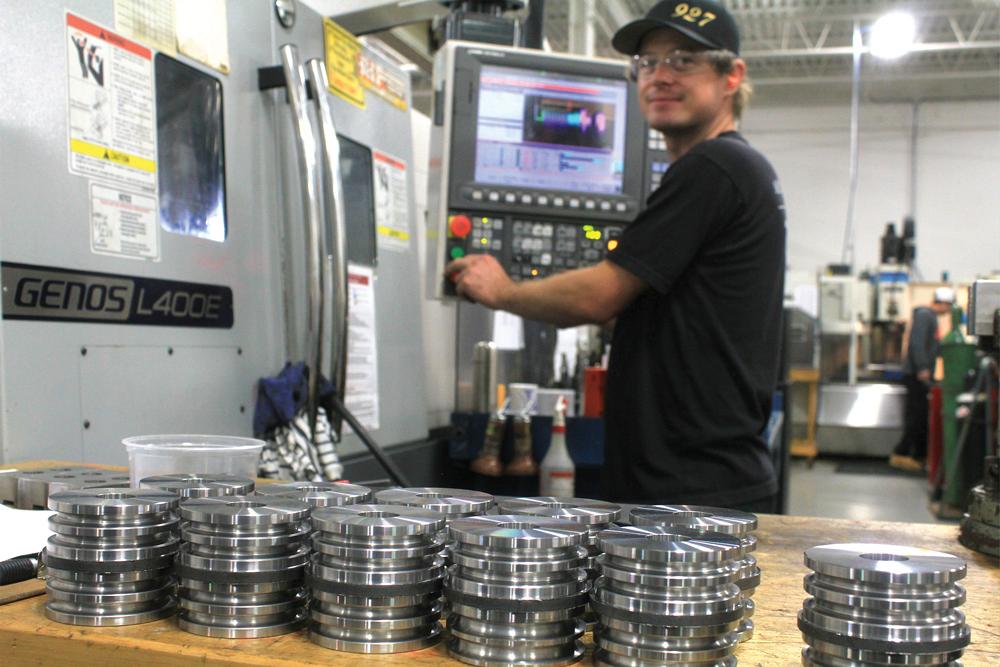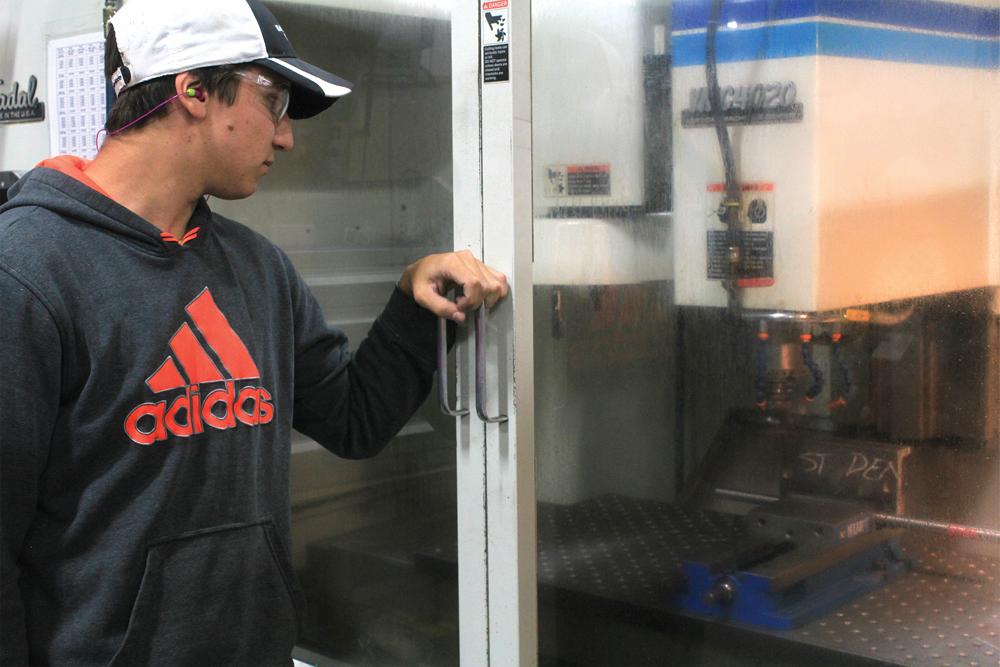- FMA
- The Fabricator
- FABTECH
- Canadian Metalworking
Teaching the Next Generation of Manufacturers
Valiant’s training program pays off for students and Windsor/Essex companies
- By Sue Roberts
- December 9, 2015
- Article
- Made In Canada

Mike Ouellette begins each six-week Valiant training session for the CTMA with classroom instruction on safety, industrial math, blueprint reading, and formulas.
A quick laugh and sparkling eyes draw you into Mike Ouellette’s passionate world of industrial training, but they don’t belie the serious task he has taken on—filling the pipeline with young people who have the desire and skills to allow Canadian manufacturers to bring back the 50 percent of manufacturing that left the shores.
When he’s not on the shop floor providing hands-on guidance or in the classroom teaching safe shop practices, blueprint reading, and math skills, he works at a desk piled high with applications from young men and women vying for a place in the program at Valiant Training and Development Centre in Windsor, Ont.
Those who are accepted are enthusiastic about manufacturing and itching to complete phase one of their training. They count themselves lucky to be on a fast track to becoming the next generation of machinists.
It’s a stark contrast to recent, and still too often present, reluctance of youth to embrace an industrial career. The list of area manufacturers eager to put these students to work is another somewhat unexpected part of the program’s equation.
All is accomplished with generous support from Valiant, an award-winning company with headquarters in Windsor that provides full service, turnkey automated production systems, and tooling around the globe.
Ouellette, skilled trades training coordinator for the program, put his tasks on pause long enough to discuss how the program came about, what about it attracts students and hiring companies, and his firm commitment to providing skilled labor to keep Canadian manufacturers globally competitive.
CIM: How did the program come about?
Ouellette:
About six years ago Valiant realized that in 10 or 15 years their skilled staff would be retiring and the people they were hiring didn’t have the level of skills they wanted. So they started their own training program to fill the gaps.They asked me to develop the program. They knew my dedication to quality from when my company was a Valiant supplier. I ran my own tool and die business for 32 years. I had taught 300 apprentices during those years but never on a day-to-day basis. I sold my building to Valiant to use as a training center. Today I work at the same desk in the same office.
The program worked. In six years it provided 140 apprentices for Valiant. After the first six months, program graduates were doing the work of people who had been in the trades for 10 years. Today we have about 12 people working in their aerospace program and others in their electrical departments, machining departments, welding cells, and with their robotics systems.
CIM: How did the program shift from an in-house initiative to training for other Windsor/Essex area manufacturers?
Ouellette: Introducing young people to manufacturing and training them to produce quality products has been a lifelong goal of Michael G. Solcz, Valiant founder. When Valiant reached its saturation point for apprentices, we knew we still needed to build industry by providing skilled tradespeople. Valiant realized the need to attract young people to the field and train them to work competitively so we can win back work that went offshore and to encourage our young workers to open their own machine shops someday to service the industry.
Then a conversation with Robert Cattle, executive director of the Canadian Tooling & Machining Association [CTMA], sparked the idea to continue the program with the involvement of CTMA and its 160 member companies.
In October 2014 we used the Valiant program as the basis for a CTMA Introductory Trades Training (ITT) pilot project that was partly funded by the Ontario government. The association provided some financial assistance and its members provided the jobs for the students. Sixteen association companies agreed to pay students during their training with the intention of moving them into apprenticeships in their own shops after they received their CTMA certificates. That worked too.
This October we had the fourth intake of students for CTMA. Each class is between 25 and 28 so we’ve provided over 100 program graduates for area companies so far. Initially companies were hesitant to sign on to the program, but following the success of the first intake, we now have over 30 area companies participating, some asking for three or four students from upcoming classes. Our participants have the correct attitude and aptitude to work, show up on time, and are confident that they are starting a career, not just “getting a job.”
We teach the students that companies need good, skilled people, and that together they will have a strong bond where everybody wins.
CIM: What is involved in the compulsory 32-week CTMA ITT program?
Ouellette: It starts with an intensive screening process, followed by three weeks of basic training in our classroom. We teach safety first, then technical math that they will use on a day-to-day basis, formulas, and blueprint reading.
We get them ready to work. We teach them to be on time every day, put in 100 percent, and to smile and say hello so they work in a pleasant atmosphere. That builds up their confidence and they understand what to do and what not to do. From there they go to the training centre’s shop floor and work on real parts for real companies. We train on manual and CNC equipment that is used in the industry right now. It’s real life.
Some parts from our shop are for Valiant, some are for other area companies, and some have even been brought back from offshore suppliers. When parts are being made for a company that has a student in the program, the student is taught on its parts so he or she ends up using the same skills to do the same work--just in different buildings. Following the six weeks at the training centre, the students continue their training on their employers’ shop floors for an additional 26 weeks.
CIM: What draws the young people into this program?
Ouellette: What is unique about this program is that students get paid to go to school. Their education is a job where they punch in and clock out. They start at $12 an hour and receive benefits. They are on a company’s payroll when they start training. The CTMA provides new safety boots and a toolbox with the basics to start their new careers--measuring instruments, indicators, hand tools, etc.
A lot of young people are not looking for a university degree or may have struggled through high school, but they are good hands-on learners. They’re too bright to be working for minimum pay or not working at all.
We bring them into the skilled trades where they can eventually make twice or three times the minimum wage, and they learn a skill that provides a career and job security. Many of them become our best machinists and assemblers. They are what industry needs.
These young people are eager and they want to learn. This program is something that they had been waiting for, something they didn’t know they wanted until they found it.
CIM: Who chooses which students make the cut?
Ouellette: We have so many people wanting to come into the program that I can’t review all of the resumes. About three years ago we hooked up with the Employment Assessment Centre to do pre-assessment and testing prior to the interview at the training centre.
Those who end up here write an aptitude test that measures their math, mechanical aptitude, and communications skills. Then I interview those who pass, make the final selections, and facilitate the hiring. Just like real life. Not everyone makes it in this field. There are students who have what it takes and those who don’t. We try to focus on those who have it. We’re not 100 percent in our choices, but our success rate has been over 90 percent.
CIM: Does Valiant’s training compete with other opportunities available at educational institutions?
Ouellette: In no way are we out to take work away from the colleges. We want them to do their part. We offer pre-apprenticeship training. We get young people interested in the skills, interested in the trade, and then encourage them to move up the ladder. Many of them end up in the college system after they have completed our program.

Classes of 25 to 28 students train on the same equipment they will use when they move on to their apprenticeships.
CIM: What surprises the students when they first see the facility?
Ouellette: The reality of manufacturing today. That industry is made for everybody. They don’t realize how automation has changed the manufacturing environment.
After her first day in the shop, one young woman said how surprised she was that she was going home just as clean as when she started.
CIM: Do you see more women entering industry?
Ouellette: Yes. I’ve brought 30 women into the program. We have eight right now. I find that the young women are quite fussy in their work, and that is a good thing. One told me she wasn’t finished with a part because she had to make it look nice, which is all part of the equation. Our trade needs that attention to detail. And it also challenges the young men to step up to compete with them.
The young people themselves, the generation in this program, don’t have any issues with having both males and females in the program. They accept training together as the norm.
It’s sometimes hard to convince the occasional shop to hire young women because they don’t have adequate facilities, but most shops have or are adapting.
CIM: Why don’t other companies develop similar programs?
Ouellette: Training is expensive because shops need to use their top skilled people as trainers and they lose their productivity.
A lot of people are training on machines that have been used for 30 years. My vision is to train these people for the future. Use the last 30 years as the basis, but incorporate new and future machines. We are trying to teach the young people to adapt to change. Technology is moving quickly.
CIM: What’s the next step, and what will help you get there?
Ouellette: We would like to spread this program all over Canada. We are trying to wake people up and get something done about training. To accomplish that goal, we need funding. We need the whole industry to speak up and tell the government what industry needs; that is, industry training for the industry.
This program might not be the perfect method to solve our skilled labor problems but it is a start. We need to take the bull by the horns and train our people so our manufacturers have what they need to beat offshore competition. Then the rest will fall into place.
CIM: What is at the bottom of your passion?
Ouellette: Training our young people. They don’t even know what they are capable of doing until you teach them. I’ve never seen so many people be so gung-ho once they begin learning. It’s like they won the lottery.
I like changing lives. It’s not just the students’ lives. Parents come to me and hug me because I took the edge off their worries about their young person’s career path.
There are graduates of the Valiant program who are working overtime and buying new cars. I have five students—all in their early 20s--who bought their first home last year. Two students from the first Valiant intake have started their own businesses and they will be hiring others. They are working in industry and stepping up to their responsibilities. That motivates me.
These people may be training my great-grandkids someday.
CTMA Introductory Trades Training program
By the numbers:
- 100 students placed with Windsor/Essex companies in the last year and a half
- 28 students currently in their six-week, compulsory training at the Valiant Training and Development Centre
- 18 to 29–age of eligible participants
- $8,000 for employers to help offset training costs
- 32-week introductory program within the Machine, Tool, Die & Mold sector
- More than 30 area companies currently participating
- $12—suggested hourly wage for students while training
For more information on the CTMA ITT program, visit www.ctma.com.
Students in the Valiant Training and Development Centre are trained in the following applications:
- CNC milling
- CNC lathes
- CNC gundrilling
- Wire EDM
- Pipefitter
- Industrial electrician
- PLC programmer
- Robot programmer
- Systems integrator
- CMM inspection
- Welder-fabricator
- Manual machining and grinding
A new Matsuura Maxia MX-520 5-axis machining center was recently added to the shop floor of Valiant’s training centre.
“We now have one of the first 5-axis machining centers in a training facility or school in Canada. I’ve talked with companies in the Montreal area and they told me that if I could train on a 5-axis, they would send a busload of students from their area to go through the program and guarantee them jobs,” said Mike Ouellette, skilled trades training coordinator at the Valiant Training and Development Centre.
Photos by James Gervais Photography.
subscribe now


Keep up to date with the latest news, events, and technology for all things metal from our pair of monthly magazines written specifically for Canadian manufacturers!
Start Your Free Subscription- Trending Articles
- Industry Events
MME Winnipeg
- April 30, 2024
- Winnipeg, ON Canada
CTMA Economic Uncertainty: Helping You Navigate Windsor Seminar
- April 30, 2024
- Windsor, ON Canada
CTMA Economic Uncertainty: Helping You Navigate Kitchener Seminar
- May 2, 2024
- Kitchener, ON Canada
Automate 2024
- May 6 - 9, 2024
- Chicago, IL
ANCA Open House
- May 7 - 8, 2024
- Wixom, MI



















